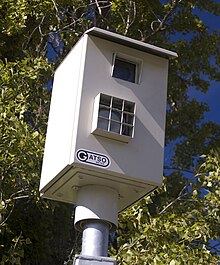
Speed limits are enforced on most public roadways by authorities, with the purpose to improve driver compliance with speed limits. Methods used include roadside speed traps set up and operated by the police and automated roadside 'speed camera' systems, which may incorporate the use of an automatic number plate recognition system. Traditionally, police officers used stopwatches to measure the time taken for a vehicle to cover a known distance. More recently, radar guns and automated in-vehicle systems have come into use.
A worldwide review of studies found that speed cameras led to a reduction of "11% to 44% for fatal and serious injury crashes".[1] The UK Department for Transport estimated that cameras had led to a 22% reduction in personal injury collisions and 42% fewer people being killed or seriously injured at camera sites. The British Medical Journal recently reported that speed cameras were effective at reducing accidents and injuries in their vicinity and recommended wider deployment. An LSE study in 2017 found that "adding another 1,000 cameras to British roads could save up to 190 lives annually, reduce up to 1,130 collisions and mitigate 330 serious injuries."[2]
- ^ Cite error: The named reference
cochranereviewwas invoked but never defined (see the help page). - ^ Science, London School of Economics and Political (25 October 2017). "Speed cameras reduce road accidents and traffic deaths, according to new study". London School of Economics and Political Science.